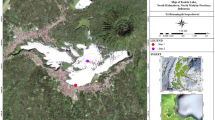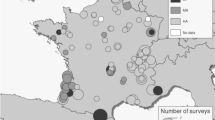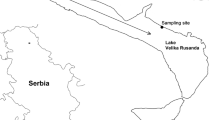Abstract
Great Lake is the largest of 14 lakes situated in Lurë National Park, in the eastern part of the Lurë Mountains, Albania. To characterize lake ecological status, epiphytic and epilithic diatom samples were collected from the lakeshore in summer 2005, 2013, and 2017. However, in 2017 no macrophytes were present, such that only epilithic diatom samples could be collected. After laboratory analysis, 52 diatom taxa were identified in July 2005, 67 in June 2013, 111 in August 2013, and 126 in August 2017. The genera Diatoma, Epithemia, Fragilaria, and Surirella were not recorded in 2017, contrary to previous years. We applied two diatom indices to asses the ecological status of the Great Lake, IPS (Indice de Polluo–sensibilité), and TDIL (Trophic Diatom Index for lakes). The IPS index indicated very good water quality in all years, while the TDIL indicated moderate water quality in 2005 and 2013 and good water quality in 2017. Because more species have indicator values for calculating the IPS than the TDIL (valve number used to calculate the IPS was above 95%, while for TDIL was below 50% of 400 counted valves), the IPS may be a more promising tool for bioindication of lakes in Albania according to the demands of the Water Framework Directive.








Similar content being viewed by others
References
Alikaj M, Brahushi F, Kupe L (2019) Ecological status assessment using diatom indices of water ecosystems in Gjirokastra district, Albania. Fresenius Environ Bull 28(2):857–862
Atici T, Obali EO (2010) The diatoms of Asartepe dam Lake (Ankara), with environmental and some physicochemical properties. Turk J Bot 34(6):541–548. https://doi.org/10.3906/bot-0912-271
Barinova S, Solak CN, Erdoğan O, Romanov R (2014) Algae and zooplankton in ecological assessment of the Işıklı Lake, Turkey. Aquat Biol Res 2(2):23–35. https://doi.org/10.12966/abr.05.02.2014
Bennion H, Kelly MG, Juggins S, Yallop ML, Burgess A, Jamieson J, Krokowski J (2014) Assessment of ecological status in UK lakes using benthic diatoms. Freshw Sci 33(2):639–654. https://doi.org/10.1086/675447
Blanco S, Ector L, Bécares E (2004) Epiphytic diatoms as water quality indicators in Spanish shallow lakes. Vie Milieu 54(2–3):71–80
Bolla B, Borics G, Kiss KT, Reskóné NM, Várbíró G, Ács É (2010) Recommendations for ecological status assessment of Lake Balaton (largest shallow lake of Central Europe), based on benthic diatom communities. Vie Milieu 60(3):197–208
Carmignani RR, Roy AH (2017) Ecological impacts of winter water level drawdowns on lake littoral zones: a review. Aquat Sci 79:803–824. https://doi.org/10.1007/s00027-017-0549-9
Cemagref (1982) Etude des méthodes biologiques quantitatives d’appréciation de la qualité des eaux. Rapport Division Qualité des Eaux Lyon - Agence financière de Bassin Rhône-Méditerranée-Corse, Pierre-Bénite, pp 1–218
Cena F (2016) Protected areas in the district of dobra and assessment of their tourist. Int J Acad Res Reflect 4(4):13–21
Cetin AK (2008) Epilithic, epipelic, and epiphytic diatoms in the Göksu stream: community relationships and habitat preferences. J Freshw Ecol 23(1):143–149. https://doi.org/10.1080/02705060.2008.9664565
Cheshmedjiev S, Mladenov R, Belkinova D, Gecheva G, Dimitrova-Dyulgerova I, Ivanov P, Mihov S (2010) Development of classification system and biological reference conditions for Bulgarian rivers and lakes according to the water framework directive. Biotechnol Biotechnol Equip 24:155–163. https://doi.org/10.1080/13102818.2010.10817832
Bory de Saint-Vincent JBGM (1824) Diatome. Diatoma. In: Audouin I et al. (eds) Dictionnaire Classique d'Histoire Naturelle. CRA-D., Vol. 5. Rey et Gravier; Baudouin Frères, Paris, pp 1–461
EN 13946:2003: Water quality. Guidance standard for the routine sampling and pretreatment of benthic diatoms from rivers. ISBN 0580419606; Pages 18. http://standards.mackido.com/en/enstandards24_view_3175.html
European Parliament (2000) Directive 2000/60/EC of the European Parliament and of the council establishing a framework for community action in the field of water policy. Off J Eur Communities L327:1–73
Golloshi A, Lika A, Hysko M (2014) Monitoring the water microbial parameters of some lakes of Lura Park. Albanian J Agric Sci, suppl. Special edition 155–157
John J, Economon-Amilli A (1990) Cyclotella cretica, a new species of diatom from the island of Crete, Greece. Diatom Res 5(1):43–50
Kahlert M, Gottschalk S (2014) Differences in benthic diatom assemblages between streams and lakes in Sweden and implications for ecological assessment. Freshw Sci 33(2):655–669. https://doi.org/10.1086/675727
Kelly M (2013) Data rich, information poor? Phytobenthos assessment and the water framework directive. Eur J Phycol 48(4):437–450. https://doi.org/10.1080/09670262.2013.852694
Kelly MG, King L, Jones RI, Barker PA, Jamieson BJ (2008) Validation of diatoms as proxies for phytobenthos when assessing ecological status in lakes. Hydrobiologia 610(1):125–129. https://doi.org/10.1007/s10750-008-9427-8
Kelly M, King L, Ní Chatháin B (2009) The conceptual basis of ecological-status assessments using diatoms. Biol Environ 109(3):175–189. https://doi.org/10.3318/BIOE.2009.109.3.175
Kociolek JP, Spaulding SA (2000) Freshwater diatom biogeography. Nova Hedwigia 71:223–241
Krammer K, Lange-Bertalot H (1988) Bacillariophyceae. 2. Teil. Bacillariaceae, Epithemiaceae, Surirellaceae. In: Ettl H, Gerloff J, Heynig H, Mollenhauer D (eds) Sübwasserflora von Mitteleuropa, 2/2. G. Fischer Verlag, Jena, p 596
Kupe L, Miho A, Çullhaj A (2011) Evaluation of trophic and Saprobic diatom index in Albanian Rivers. J Int Environ Appl Sci 6(5):692–698
Lange-Bertalot H, Hofmann G, Werum M, Cantonati M (2017) Freshwater benthic diatoms of Central Europe: over 800 common species used in ecological assessment. Koeltz Botanical Books, Schmitten-Oberreifenberg
Mann DG (1990) The species concept in diatoms. Phycologia 38:437–495
Miho A, Lange-Bertalot H (2001) Data on microflora of Albanian waters: diatoms from glacial lakes. Studime Biologjike Special Issue 5(6):234–236 [In Albanian]
Miho A, Tase D, Lange-Bertalot H (2004) Overview on diatoms from Ohrid Lake. Proceedings of BALWOIS pp 1–9
Miho A, Çullaj A, Lazo V, Hasko A, Kupe L, Bachofen R, Brandl H, Schanz F (2006) Assessment of water quality of some Albanian rivers using diatom-based monitoring. Alban J Nat Sci 19:94–105
Picinska-Faltynowicz J, Blachuta J (2008) Zasady poboru i opracowania prób fitobentosu okrzemkowego z rzek i jezior. Przewodnik metodyczny, Warsaw
Potapova M, Hamilton PB (2007) Morphological and ecological variation within the Achnanthidium minutissimum (Bacillariophyceae) species complex. J Phycol 43:561–575. https://doi.org/10.1111/j.1529-8817.2007.00332.x
Prygiel J, Coste M (2000) Guide méthodologique pour la mise en oeuvre de l’Indice Biologique Diatomées NF T 90-354. Agences de l’Eau, Ministere de l’Aménagement du Territoire et de l’Environnement, Cemagref
Round FE, Crawford RM, Mann DG (1990) The diatoms. Biology and Morphology of the Genera. Cambridge University press, Cambridge
Sanal M, Demir N (2018) Use of the epiphytic diatoms to estimate the ecological status of Lake Mogan. Appl Ecol Environ Res 16(3):3529–3543. https://doi.org/10.15666/aeer/1603_35293543
Shumka S., Miho A (2006) Assessment of the water quality and trends at the Drini cascade system based on plankton data. International Conference on Water Observation and Information System. BALWOIS 2006
Stenger-Kovács CS, Buczkó K, Hajnal É, Padisák J (2007) Epiphytic, littoral diatoms as bioindicators of shallow lake trophic status: trophic diatom index for lakes (TDIL) developed in Hungary. Hydrobiologia 589:141–154. https://doi.org/10.1007/s10750-007-0729-z
Stevenson RJ, Hashim S (1989) Variation in diatom community structure among habitats in sandy streams. J Phycol 25:678–686
Taylor JC, Harding WR, Archibald CGM (2007) WRC Report TT 281/07: A methods manual for the collection, preparation and analysis of diatom samples version 1.0. Water Research Commission, The Republic of South Africa
Teittinen A, Taka M, Ruth O, Soininen J (2015) Variation in stream diatom communities in relation to water quality and catchment variables in a boreal, urbanized region. Sci Total Environ 530:279–289. https://doi.org/10.1016/j.scitotenv.2015.05.101
Trbojević IS, Predojević DD, Subakov-Simić GV, Krizmanić JŽ (2019) Periphytic diatoms in the presence of a cyanobacterial bloom: a case study of the Vrutci reservoir in Serbia. Arch Biol Sci 71(2):215–223. https://doi.org/10.2298/ABS181120003T
Varol M, Blanco S, Alpaslan K, Karakaya G (2018) New records and rare taxa for the freshwater algae of Turkey from the Tatar dam reservoir (Elazığ). Turk J Bot 42(4):533–542 https://doi.org/10.3906/bot-1710-55
Winter JG, Duthie HC (2000) Stream epilithic, epipelic and epiphytic diatoms: habitat fidelity and use in biomonitoring. Aquat Ecol 34(4):345–353 https://doi.org/10.1023/A:1011461727835
Wojtal A, Sobczyk Ł (2006) Composition and structure of epilithic diatom assemblages on stones of different size in a small calcareous stream (S Poland). Algol Stud 119:105–124. https://doi.org/10.1127/1864-1318/2006/0119-0105
Wunsam S, Schmidt R, Müller J (1999) Holocene lake development of two Dalmatian lagoons (Malo and Veliko Jezero, isle of Mljet) in respect to changes in Adriatic Sea level and climate. Palaeogeogr Palaeoclimatol Palaeoecol 146(1–4):251–281. https://doi.org/10.1016/S0031-0182(98)00147-3
Zębek E, Bonar A, Szymańska U (2012) Periphytic diatom communities in the littoral zone of the urban lake Jeziorak Mały (Masurian Lake District, Poland). Ekológia (Bratislava) 31(1):105–123. https://doi.org/10.4149/ekol201201105
Acknowledgments
We thank Dag Hjermann, NIVA, for help with Fig. 2. The project was funded by the Norwegian Ministry of Foreign Affairs, Project title: “Assessment of ecological status according to the Water Framework Directive – intercalibration among W-Balkan countries” (No RER-14/0008).
Author information
Authors and Affiliations
Corresponding author
Ethics declarations
Conflict of interest
The authors confirm the absence of any conflict of interest.
Additional information
Publisher’s note
Springer Nature remains neutral with regard to jurisdictional claims in published maps and institutional affiliations.
Electronic supplementary material
ESM 1
(DOCX 60 kb)
Rights and permissions
About this article
Cite this article
Vidaković, D., Krizmanić, J., Ndoj, E. et al. Changes in the diatom community in the great lake (Lurë National Park, Albania) from 2005 to 2017 and first steps towards assessment the water quality. Biologia 75, 1815–1824 (2020). https://doi.org/10.2478/s11756-020-00538-3
Received:
Accepted:
Published:
Issue Date:
DOI: https://doi.org/10.2478/s11756-020-00538-3




